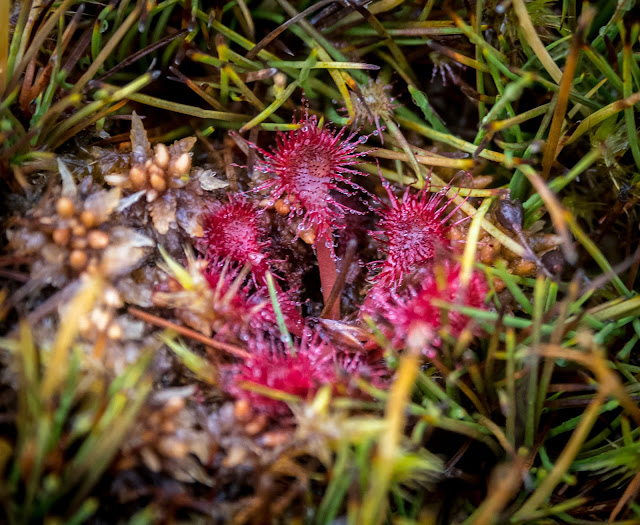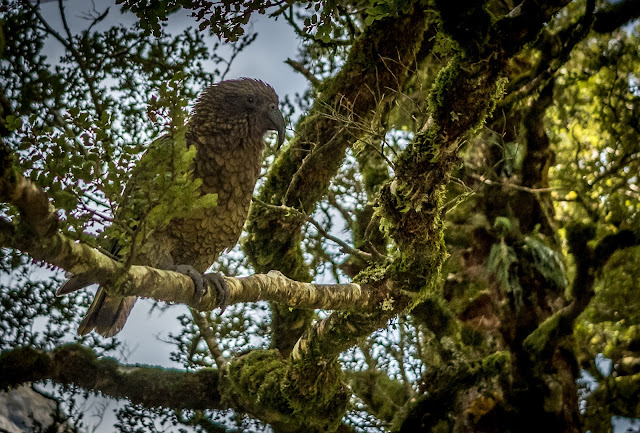In the south-west corner of New Zealand lies the Fjordland National Park. It contains several classic walks, the most famous of which is the 'Milford Track'. Because it is so popular, it is necessary to book it a year before you want to go. In the course of the last year I developed a dodgy knee, with MRI evidence of a torn medial meniscus, and I have spent several months worrying whether the whole project might be too hard.
Fjordland gets about 200 days of rain a year, and inclement conditions are very common.
In the event, we have been extremely lucky. My knee responded to various treatments, and the weather was perfect.
There had been several weeks drought before we arrived, which is not ideal for the waterfalls which are a feature of the walk. We started on Thursday February 1st. Heavy rain began the night before, and 200mm of rain were dumped over 36 hours. Snow on the tops. Although that sounds bad, for us it was fine, as the first day was spent being taken by coach from Queenstown to Lake Te Anau, and then boat to Glade House. Thus we were under cover for most of the day, and the waterfalls were topped up nicely.
There were 49 trampers in the guided group, and four guides. Roughly 25% Americans, 25% Japanese, 25% Australian, and the rest miscellaneous. Alan was a delightful young Mexican travel vlogger, with 1,300,000 followers.
Check out his video of the trip. Its in Spanish, but his enthusiasm transcends language.
Check out his video of the trip. Its in Spanish, but his enthusiasm transcends language.
The plan was:
Day one. (Thursday 1st). Coach and boat from Queenstown to Te Anau and walk to the beginning of the track.
Day two (Friday 2nd). 16 kilometres fairly flat along the Clinton River to Pompolona Lodge.
Day three (Saturday 3rd). 15 kilometres climbing 664 metres over Mackinnon Pass to Quintin Lodge. Optional extra 4 km walk to Sutherland Falls (580m high).
Day four (Sunday 4th). 21 kilometres along the Arthur Valley to Sandfly Point on Milford Sound to be taken by boat to Mitre Peak Lodge.
Day five. (Monday 5th). Cruise Milford Sound. Coach back to Queenstown.
Day five. (Monday 5th). Cruise Milford Sound. Coach back to Queenstown.
And thus it came to pass. First day it poured cats and dogs.
Then fine weather for the three critical days. Gushing waterfalls. Just beautiful!
Then fine weather for the three critical days. Gushing waterfalls. Just beautiful!
George crossing the bridge from Glade House
Ready to go
Snow on the mountains above Glade House in the night
Alan the happy vlogger from Mexico
Brian in the wetland
Sean from Cape Cod
Sundew. It eats insects.
Lichen
The Clinton River
Clinton Valley
Hundreds of waterfalls
Off to Mackinnon Pass
Lots of bridges
Clinton Gorge
Approaching Mackinnon Pass
Climbing the Mackinnon Pass on a hot day. Snow on the tops.
From the top of the pass, looking back down the Clinton Gorge.
Next down to the Arthur Valley
Descending
Quite a cold wind on top of the pass
A beautiful cascade of waterfalls
Soft fern
Kea
South Island Robin
Sutherland Falls
Below the falls
Arthur Valley
Mission accomplished!
Moods of Milford Sound
A note on photography
The photographic challenge of the Milford Track, and other similar NZ valley walks, is that there is an extreme dynamic range between the bright sky, and the dark mountains. Cameras cannot see as well as our human eyes, with the result that the bright bits get 'blown out' to pure white, and the dark bits get reduced to pure black. So the photos seem a bit disappointing compared to what we remember seeing.
See the histogram at top right. The spike on the left represents all the blacks in the picture, spilling off the edge. The spike on the right is the whites. Not a lot in the middle.
The clouds are 'washed out' to white. The bush is nearly black. With your eyes, you would see both the clouds in the sky, and the green colour of the bush.
I used a technique called High Dynamic Range (HDR) to counter this. By shooting three photos in quick succession, with the first under-exposed by 2 stops, the second (see above) set normal, and the third over-exposed by 2 stops, and then combining them with software called Aurora HDR 2018, the three get combined, lifting the colours.

Under-exposed (see clouds) Normal Over-exposed (see colour in shadows)
When combined with HDR they look like this.
See how the histogram has changed to bring out the mid-tones. Hopefully more like what we actually saw.





































No comments:
Post a Comment